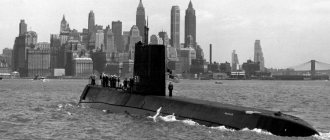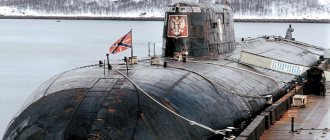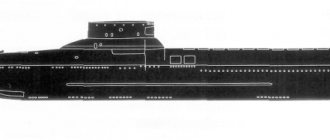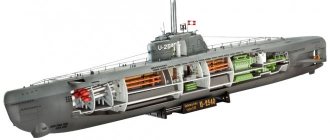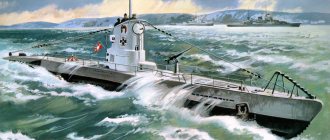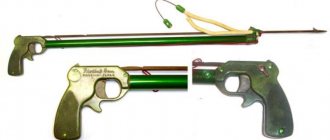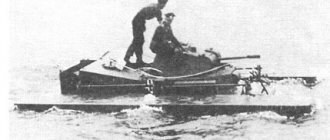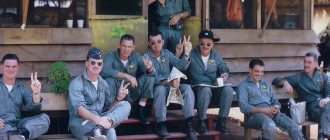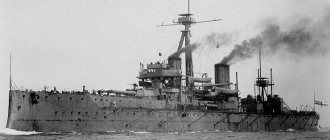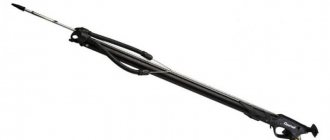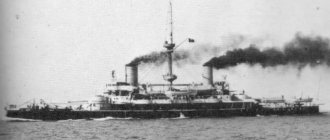Author: zaCCCPanec
09 September 2022 15:22
Tags: K-3 Leninsky Komsomol USSR Navy history of tragedy
12909
10
In September 1967, the nuclear submarine K-3 Leninsky Komsomol returned to its home port from combat duty. Those greeting them knew that an emergency had happened on the submarine not far from its native shores. But the boat was returning under its own power, and there was hope that serious consequences had been avoided... But the K-3 flag at half-mast was a sign of trouble. This is how the ships on which crew members died during the voyage return to base...
Stalin's last project.
0
See all photos in the gallery
The K-3 submarine became the first domestic nuclear-powered ship and the third nuclear-powered submarine in the world, after the American Nautilus and Seawulf. Development of the K-3 began in the context of the growing Cold War with the West. The creation of a nuclear submarine was supposed to allow the USSR to maintain military parity in this confrontation. The creation of the nuclear-powered ship began on September 12, 1952, when Joseph Stalin signed the government decree “On the design and construction of object 627.” Needless to say, work on the first nuclear submarine was carried out in the strictest secrecy.
0
Construction of the K-3 proceeded at an incredible pace, undreamed of by either the then American competitors or modern Russian shipbuilders. Five years passed from the idea of the nuclear-powered vessel to its launch. For comparison, the American Nautilus took almost a decade to build. As fleet historians note, Project 627 boats were the first to appear in cetacean shapes, for which they received the nickname “whales.” The general designer of the K-3 was Vladimir Nikolaevich Peregudov, who was later awarded the title of Hero of Socialist Labor for his brainchild.
×
THE COMMANDER'S FATE
Six months later, Stepanov was written off ashore and transferred to the Black Sea Higher Naval School named after P.S. Nakhimov.
There he was awarded the Order of the Red Star for saving the first-born of the Soviet nuclear fleet. What then happened to the fate of this officer, who saved not only his ship, but the entire Norwegian Sea from radioactive contamination? Last summer one of us tried to find traces of him in Sevastopol. The school where Stepanov taught no longer exists. Nobody knows where his archives are. The last hope is the regional military registration and enlistment office, where he was registered. But then there was a different country, and now the military registration and enlistment office serves the new state. A girl in a Ukrainian uniform kindly explains that all the personal files of Soviet officers have long been destroyed. At best, a duplicate has been preserved somewhere in Kyiv. But the chances are slim.
To clear her conscience, a girl ensign climbs onto the archival shelves, and suddenly the personal file of Captain 1st Rank Stepanov falls from above! It seems that he himself, from the other world, pushed this skinny daddy.
“Wow,” the girl is amazed, “they didn’t burn it.”
What can “Personal File of a Reserve Officer” tell you? A lot of what makes up the external outline of the service, and almost nothing from his personal life. Nevertheless, we are trying to understand this man from his last paper trail on earth.
So, Yuri Fedorovich Stepanov was born on May 15, 1932 in Kalinin. He graduated from the Riga Nakhimov School, in 1952 – the Higher Naval Diving School, in 1966 – the Higher Special Officer Classes. Navigator by profession. Appointed commander of the cruising submarine K-3 on July 5, 1967.
From cadet and officer certifications: “...was a company sergeant major. Champion of schools and universities in classical wrestling. He navigates the situation at sea well and quickly makes informed decisions. An officer with high strong-willed qualities.” Another entry: “In September 1967, in a difficult work situation, he received carbon monoxide poisoning with a short-term loss of consciousness and subsequent mental trauma. Over the course of 3-4 months I fainted five times.”
Thus his commanding career was interrupted. Instead of a bridge there is the office of the head of the correspondence department of the Black Sea VVMU. He did not give up and still hoped to return to the active fleet. In 1976, he completed an internship as a commander of a nuclear submarine in the Northern Fleet. But the doctors were inexorable: he was unfit for service in the submarine. Another would have broken. But Yuri Stepanov did not retreat: commander of a training battalion, teacher, and then deputy head of the Department of Navy Tactics. For success in training cadets he was awarded the Order of the Red Banner of Labor. Retired in 1989. Worked as a librarian. Son Vyacheslav, daughter Tatyana. The date of death is not noted in the personal file. Somewhere in the 1990s. He was buried near Sevastopol.
Gift for the anniversary of the revolution.
0
The first commander of K-3 was Captain 1st Rank Leonid Osipenko. Secrecy prevented his name from spreading throughout the country. But for its time, the achievements of the K-3 were unique: it reached speeds of up to 30 knots (which exceeded the capabilities of its American rivals), dived to depths of up to 300 meters and could be on a three-month combat campaign without a single ascent. Leonid Osipenko was awarded the title of Hero of the Soviet Union. He became the first to be awarded this title after the war. K-3 was launched on October 9, 1957. This historical, epoch-making event occurred just five days after another revolutionary breakthrough of the USSR - the launch of the first satellite. The flag of the USSR Navy was raised over the boat on June 1, 1958, after which work began on fine-tuning the new equipment and eliminating identified deficiencies. In addition, a new coastal infrastructure was urgently built, because the nuclear-powered ship required fundamentally new maintenance. Since 1959, the boat was based in Severodvinsk, becoming part of the separate 206th submarine brigade. In 1961, K-3 went on its first combat duty in the Atlantic.
1954 July 21
included in the lists of Navy ships.
1955 September 24
laid on the slipway of workshop No. 42 of shipbuilding plant No. 402 in the city. Molotovsk as the first nuclear-powered cruising submarine in the USSR.
1957 January
Enlisted in
the 150th infantry brigade of the 339th brigade brigade of the BelVMB Northern Fleet
.
1957 August 7
removed from the slipway of workshop No. 42.
1957 August 9
launched by the side method.
1957 September
The physical start-up of both reactors was carried out, and tests of the power plant from the Leopard power plant began.
1958 June 26
task No. 1 KPL-57 was accepted by the Navy Submarine Directorate under the leadership of the Deputy. Navy Civil Code Vice Adm. Ivanova V.N. with a "good" rating.
1958 July 1
The USSR Naval flag was raised. The ceremonial raising of the flag was attended by the Civil Code of the USSR Navy, Admiral S.G. Gorshkov, and the Minister of Shipbuilding Industry of the USSR, B.E. Butoma. and President of the USSR Academy of Sciences, Academician A.P. Aleksandrov By coincidence, the rise occurred a few minutes before the evening lowering of the flag. With the permission of the Commander-in-Chief, the flag was left overnight.
1958 July 3
State tests have begun.
1958 July 4th
at 10.03, for the first time in the history of the Russian fleet, the submarine began to move under a nuclear power plant.
1958 August
task No. 2 KPL-57 was accepted by the Navy Submarine Directorate under the leadership of the Deputy. Navy Civil Code Vice Adm. Ivanova V.N. with a "good" rating.
1958 from November 26 to December 2
In the Kandalaksha Bay of the White Sea, a deep-sea dive was carried out to a depth of 310 meters and swimming without surfacing for three days at a speed of 20 knots. At periscope depth, a collision occurred with a submerged log, as a result of which the periscope was bent.
1958 December 17
An acceptance certificate was signed, the submarine was accepted for trial operation under industry guarantees that identified deficiencies will be eliminated. Responsible deliverer Dovgan N.N., Chairman of the State Commission, Vice Adm. Ivanov V.N., commander - cap. 2nd rank Osipenko L.G. During the tests, the submarine made 29 dives, carried out 5 trips to sea for a total duration of 25 days, covered 3801 miles in 450 running hours, of which 2002 miles were submerged in 193 hours. The time spent under water was 58 hours 18 minutes, during which time the submarine covered 860 miles at an average speed of 14.8 knots. For the first time, an underwater speed of 23.3 knots was achieved; the State Commission noted the good controllability of the submarine at this speed in course and depth. Achieving an underwater speed of 23.3 knots at 60% of the power of the power plant indicated that the specification speed of 25 knots could be achieved at 80% of the thermal power of the nuclear power plant. Underwater tests were interrupted at the 59th hour due to a leak in the circulation pumps of the 1st circuit. Due to the failure of individual mechanisms and equipment of the main power plant, it was not possible to fully implement the approved test program.
1959 January
By resolution of the Council of Ministers of the USSR it was transferred into trial operation. Inspection of mechanisms and modernization work have begun on the submarine.
1959 March
assigned tactical number
K-3
.
1959 March 12
included in the
206th brigade of the Northern Fleet
with a base in the city. Severodvinsk.
1959 June
put into operation, sea trials continued under the leadership of a trial operation group appointed by a joint decision of the State Navy, the Chairman of the State Committee of the USSR Council of Ministers for Shipbuilding and the Minister of Medium Engineering.
1959 July 23
for the successful development of new technology to the submarine commander cap. 1st rank Osipenko L.G. By decree of the Presidium of the Supreme Council, he was awarded the title of Hero of the Soviet Union, participants in the creation of the submarine received orders and medals.
1959 from August 20 to September 11
completed the transition of a submarine from the White Sea to the Barents Sea to develop a base in Zapadnaya Litsa Bay. The boat took part in the exercise of the anti-submarine defense forces of the Northern Fleet on the topic “Search and pursuit of a nuclear submarine”, and in testing hydroacoustic stations on the cruiser. The hike was carried out to latitude 79˚ with a return to the White Sea.
1959 from November 1 to 15
going on the first long hike. By decision of the Navy Civil Code, the submarine, having a faulty main power plant on the starboard side, sailed under the ice edge in the Kara Sea and then in the Greenland Sea to a latitude of 79˚ to test its autonomy at high latitudes. While under the ice in the Greenland Sea, the main generator on the port side and the main turbo-gear unit on the starboard side simultaneously failed. Thanks to the high special training, initiative and courage of the personnel of the electromechanical warhead, complex modes of movement and switching of technical means were used, which made it possible to carry out the tests safely. The voyage was also complicated by the fact that when surfacing in the Greenland Sea, due to the lack of sufficient experience in operating the EL-1 echo ice meters, the submarine hit the ice and received damage to the wheelhouse fencing and retractable devices.
1959 from August 22 to August 30
made an exit in which she sailed under the pack ice along the Franz Victoria Trench to 81˚45' N latitude in order to test navigation systems in high latitudes. Before diving under the ice, the personnel showed dedication and high specialist knowledge in the work to eliminate large hydraulic leaks.
1959 from December to May 1960
delivered for repair and modernization to plant No. 402 in the city. Severodvinsk for the installation of the Sila N-627 navigation complex, a deaeration and water treatment plant and a number of modernization works with the replacement of failed equipment. Some of the instruments of the navigation complex were located in the first compartment, and the second chart room was also equipped there, but as a result of alterations, the four lower torpedo tubes were inactive, and the supply of torpedoes was reduced by almost half.
1960 January
transferred to
the 339th Brremstrpl SF
.
1960 from December to February 1961
mooring tests of the submarine and comprehensive tests of the deaeration installation were carried out, as a result of which a decision was made by the Navy Civil Code and the State Committee for Shipbuilding under the Council of Ministers of the USSR on the installation of the deaeration installation as unsuitable for operation.
1961 from May 26 to August 7
The sea trials program was completed and important tests for swimming under ice were practically completed: controlling the submarine in reverse and vertical ascent without moving.
1961 August 7
transferred to the newly formed
3rd division of the Northern Fleet
with a base in Malaya Lopatka Bay.
1961 from August 17 to 31
completed a voyage to latitude 81˚40' with a 60-mile entry under the ice into the Arctic basin through the Victoria Strait.
1961 from September 20 to 24
carried out firing of practical torpedoes.
1961 December
went to the training grounds to practice a combat training course, but due to malfunctions in the power plant, tasks No. 3 and No. 4 were not completed.
1962 spring
At the permanent base, navigational repairs of the submarine were carried out by factories No. 10 and No. 402 with the installation of steam collectors and drydocking.
1962 from July 4 to 10
made a control exit before going to the North Pole.
1962 July 11
left the Zapadnaya Litsa Bay on a campaign to storm the North Pole under the leadership of Rear Adm. Petelina A.I. Before leaving, the boat was visited by the Navy Civil Command adm. Fleet Gorshkov S.G., Head of the Main Political Directorate of the Navy, Vice Adm. Grishanov V.G., Chief of the General Staff of the Navy, Admiral Kasatonov V.A., Deputy. Navy Civil Code Vice Adm. Ivanov V.N., head of the Navy GTU, engineer-vice-adm. Kotov P.G., Head of the Hydrographic Service of the Navy, Vice Adm. Rassokho A.I., Commander of the Northern Fleet, Vice Adm. Lobov S.M. and other high officials.
1962 July 12
By the end of the day, a malfunction of the circulation pump for cooling the main condenser was discovered. Three bearings were replaced underwater; the repair lasted about 14 hours.
1962 July 13
at 11.30 the boat surfaced in the Greenland Sea to meet with the minesweeper to clarify data on the ice situation. Due to poor hydrometeorological conditions, the meeting took place only at 18.00.
1962 July 14
At about 10.45 at latitude 79º, in a submerged position, the submarine entered under the ice edge.
1962 July 15
the first ascent in the Arctic ice during the trip at a point with coordinates 84˚08'N, 0˚48.5'E.
1962 July 17
at 06.59.11 Moscow time, for the first time in the history of the Russian fleet, the submarine passed at the North Pole point in a submerged position.
1962 July 18
the second ascent during the trip in the Arctic ice at a point with coordinates 84˚54'N, 0˚01.5'W.
1962 July 19
the third ascent during the trip in the Arctic ice at a point with coordinates 79˚40'N, 0˚41'W. The navigation discrepancy was 34 miles.
1962 July 20
at 13.40 pl passed the edge of the ice. 1294 miles covered in 178 hours while under the ice. At 14.00 the submarine surfaced.
1962 July 21
pl returned from a trip to the North Pole to Gremikha. The leader of the campaign is Rear Adm. Petelin A.I., commander of the cap. 2nd rank Zhiltsov L.M. and the commander of the warhead-5 engineer cap. 2nd rank Timofeev R.A. were awarded the title of Hero of the Soviet Union. The awards were presented personally by the General Secretary of the CPSU Central Committee N.S. Khrushchev. All personnel of the boat were awarded orders and medals.
1962 October 9
By order of the Navy Civil Code, the honorary name “Lenin Komsomol” was assigned.
1962 September
depressurization of the fuel elements was discovered.
The submarine arrived at ship repair plant No. 893 in the city. Severodvinsk for repairs and modernization and is temporarily subordinated to the 339th brigade of the Northern Fleet
.
1963 from February 26 to October 29, 1965
The submarine was transferred for further repairs with the replacement of the reactor compartment. The spent fuel was unloaded, and the compartment was filled with a special compound. A number of modernization works were carried out on the submarine with the installation of a new navigation complex "Sigma", equipment for automatic, manual and program control of the submarine and control of emergency equipment.
1963
The crew of the boat was awarded the Challenge Red Banner of the Komsomol Central Committee.
1964 July 29
The Krasnaya Zvezda newspaper published an open letter from the crew of the Leninsky Komsomol boat with the initiative to start socialist competition in the Armed Forces in honor of the 20th anniversary of Victory in the Great Patriotic War. This movement was called the “Combat Glory Relay.”
1965 from October 29 to November 7
The sea trials program has been completed.
1965 November 24
A state act was signed on the completion of repairs and transfer of the submarine to the Navy.
1965 November 29
The submarine arrived at its permanent base in the city. Western Faces.
1965 December 17
The submarine was visited by the first cosmonaut of the planet, Hero of the Soviet Union, Colonel Yu.A. Gagarin. accompanied by the 3rd Secretary of the Komsomol Central Committee, B.N. Pastukhov. and made an entry in the ship's historical log.
1966 March 23
When surfacing for a communication session north of the Russky lighthouse, the submarine encountered an ice field carried out from the White Sea, as a result of which a dent was formed on the conning tower fence and the periscope was bent.
1966 from July 10 to August 29
completed the tasks of the first combat service in the Atlantic Ocean, the Sargasso Sea and the Gulf of Mexico, having on board 4 torpedoes with special ammunition. The voyage lasted for 49 days without surfacing.
1966 March to June
completed a test program on the following topics: “Egorlyk” (testing of anti-aircraft weapons), “Spar”, “Tourmaline”, “Ton” (testing of emergency systems); "Augustine" (light hull coating test).
1966 June
The submarine was filmed on the surface while moving, the moments of immersion and ascent.
1967 from March 12 to April 30
Scheduled docking and cleaning of hard-to-reach areas of the pressure hull of the submarine was carried out at SRZ-10 in the mountains. Polar.
1967 from June 18 to 21
The submarine carried out tests on surfacing in ice and breaking through ice from 10 to 80 cm. The tests were carried out successfully, but minor damage was sustained to the conning tower hull and the Svet station antenna.
1967 July 10
entered her second combat service in the Mediterranean Sea, carrying 4 torpedoes with special ammunition on board. During his service, the sailor underwent surgery.
1967 September 8
upon returning from combat service on the 56th day of the campaign northeast of the Faroe Islands at a point with coordinates 64˚ N, 04˚ W.
at a depth of 49 meters at 01.52 a fire broke out in the 1st compartment. When the personnel moved to the 2nd compartment, the fire spread there too. While trying to reconnaissance of the situation in the 2nd compartment, a wave of carbon monoxide burst into the central post. All 14 people who were in the 3rd compartment at that moment lost consciousness. Deputy commander for political affairs cap. 2nd rank Zhilyaev D.A., having regained consciousness on the bridge, went down to the central post, and by telephone to the control panel of the power plant he ordered the commander of the movement division, capt. engineer. 3rd rank to Nekrasov Yu.D. take command of the ship, send an emergency party to fight for the survivability of the central post and save the personnel. The order was quickly carried out, but during this time Art. died in the hold of the central post from severe carbon monoxide poisoning. 2 tbsp. Slukin M.I.
The tugboat MB-52, the rescuer Beshtau, the large anti-submarine ship Stroyny and the cruiser Zheleznyakov were sent to help K-3 The first to approach the emergency submarine was the reconnaissance ship "Vertical", aimed at the lost submarine by Tu-16 aircraft and accompanied it to the USSR terrorist ports. As a result of the accident, 38 people from the crew and the flagship chemist of the division, Cap. Lieutenant Smirnov V.N. The submarine maintained its course and returned to its home base on its own.
1967 September 11
arrived at its permanent home base.
1967 September 14
The dead crew members were buried in a mass grave near the village of Zaozerny, Kola district, Murmansk region. For their demonstrated steadfastness and loyalty to their military duty, all the dead sailors, petty officers and officers are included in the Book of Honor of the Red Banner Northern Fleet. Combat friends provided financial assistance to the families of the victims with the funds collected. By the decision of the USSR Ministry of Defense, Marshal of the Soviet Union A.A. Grechko, the families of fallen officers and long-term servicemen were provided with separate apartments in the cities of Moscow and Leningrad. Wife of midshipman Butorin A.A. At her own request, she moved to permanent residence in the mountains. Severodvinsk. According to the conclusion of the state commission chaired by the 1st Deputy Civil Code of the USSR Navy, Adm. Fleet Kasatonov V.A., the fire occurred as a result of hydraulic oil breaking through the paronite gasket in the ventilation valve machine of the main ballast tank No. 2 on the starboard side. Under operating pressure, highly atomized hydraulic oil hit the compartment; the outbreak occurred due to the technically permissible sparking standards of any electrical appliance or electric lamp under conditions of an increased, but permissible percentage of oxygen in the compartment. The actions of the personnel were assessed as correct.
1967 from September 14 to November 5
Emergency repairs were carried out at the Sevmashpredpriyatie PA in the city. Severodvinsk.
1968 from April 20 to May 5
The planned docking of the submarine was carried out at the Gremikha Bay dock.
1968 from July 21 to July 29
submarine with
184 crew
under the command of Capt. 2nd rank Zhukova A.Ya. took part in the tactical exercise of the Red Banner Northern and Twice Red Banner Baltic Fleets together with the fleets of the Warsaw Pact countries “North” under the leadership of the Civil Code of the USSR Navy adm. Fleet of the Soviet Union Gorshkova S.G.
1968 from August 26 to December 21
Navigation repairs were carried out at SRZ-10 in the mountains. Polar.
1968 October 17
In connection with the 50th anniversary of the Komsomol, she was awarded the Commemorative Banner of the USSR Ministry of Defense.
1969 December 8
The submarine arrived in Pala Bay at SRZ-10 in the mountains. Polar for production of medium repairs with modernization.
1971 February 25
by the directive of the National General Staff of the Navy of February 5, 1971 and the directive of the National General Staff of the KSF of February 25, 1971, it was transferred to the
17th dpl of the Northern Fleet
.
1971 December 28
repairs have been completed at SRZ-10 in the city. Polarny and pl moved from Pala Bay to Bolshaya Lopatkina Bay for final calculation and loading of spare parts.
1972 from January 8 to 9
Having made an inter-base transition, she arrived as part of the
17th Northern Fleet Division
to its permanent base in Gremikha Bay.
1972 from October 29 to November 5
took part in exercises for the prize of the Navy Civil Code to detect SSBNs.
1973 from May 12 to June 1
completed the tasks of the third combat service in the Atlantic Ocean and the Mediterranean Sea.
1974 from March 15 to May 5
completed the tasks of the fourth combat service in the Norwegian Sea and the North Atlantic with an “excellent” rating.
1975 February
while the submarine was in the combat training range at a depth of 60 meters, a short circuit occurred in the automatic switch of the backup feed pump in the 7th compartment. The fire was extinguished by supplying a fire extinguisher from the volumetric chemical fire extinguishing system from the 8th compartment; 2 people received serious burns.
1975 from April 24 to June 13
completed the tasks of the fifth combat service in the Barents, Norwegian and Greenland Seas with an “excellent” rating.
1975
The nuclear submarine
K-3 "Leninsky Komsomol"
is included in the annals of the Komsomol's labor affairs, and its crew was awarded the Certificate of Honor of the Komsomol Central Committee and was awarded the Memorial Banner of the USSR Ministry of Defense and the Main Political Directorate of the Soviet Army and Navy.
1976 from January 31 to February 21
The planned docking of the submarine was carried out at the Gremikha Bay dock.
1976 from June 1 to June 27
emergency docking of the submarine was carried out at the dock at SRZ-10 in the city. Polar.
1977 July 25
reclassified into a large square.
1977 from December 29
at SRZ-10 in Pala Bay in the mountains. Polyarny was put into medium repair with replacement of cable routes.
1981 January 8
During repair work, a fire occurred, as a result of which the recently replaced cable routes burned out.
1981 December 30
Medium repairs were completed and the submarine was handed over to
the 184th crew
for transition to a permanent home base.
1982 from May 25 to June 25
completed the tasks of the sixth combat service with
the 184th crew
for 32 days in the Barents, Norwegian and Greenland Seas with an “excellent” rating. The military service was dedicated to the 19th Congress of the Komsomol.
1982 August 15
The submarine was accepted by the main crew from
the 184th crew
.
1983 January
delivered for repair to SRZ-10 in the city. Polar.
1984 September 28
After the completion of repairs, it was introduced into the permanent readiness forces.
1985
The submarine took part in the exercises: “Ocean-85”, “Atlantika-85”, “North-85”.
1985 from July 2 to July 27
completed the tasks of combat duty and sixth combat service in the Norwegian Sea.
1986 April
delivered for repair to SRZ-10 in the city. Polar.
1986 September
handed over to the
K-21
to continue repairs.
1987 September 20
The submarine with the
K-21
, without completing the mid-term repairs, arrived at its permanent base in the city. Gremikha.
1987 October 17
By order of the Navy Civil Code, she was removed from the Navy's combat ranks.
1988 September 9
reorganized into a training vessel and laid up in Gremikha Bay.
1989 March 14
reclassified as a large submarine, assigned the new number
B-3
.
1993 September 30
transferred to
the 285th dnpl storage unit of the Northern Fleet
.
1993 November 5
transferred to
the 14th SLBM storage fleet
.
November 2002
towed to the Federal State Unitary Enterprise “10 Shipyard” in the city. Polar for disposal, but subsequently a decision was made to convert the submarine into a museum.
2003 July
The unloading of nuclear fuel has been completed at the Federal State Unitary Enterprise "10 Shipyard".
year 2009
handed over to the civilian crew and towed to the Federal State Unitary Enterprise "Shipyard Nerpa".
During her time in the Navy, she was the first to reach the geographic point of the North Pole, performed 6 combat tours, and covered 128,443 miles in 14,115 sailing hours. The first commander of the submarine, cap. 1st Rank Osipenko L.G. On July 23, 1959 he was awarded the title of Hero of the Soviet Union. For the courage and heroism shown during the performance of a special task, commander capt. 2nd rank Zhiltsov L.M. and commander of the warhead-5 engineer-capt. 2nd rank Timofeev R.A. On July 21, 1962, they were awarded the title of Hero of the Soviet Union. By the decision of the Komsomol organization of December 17, 1965, Colonel Yu.A. Gagarin, Hero of the Soviet Union, was elected an honorary member of the Komsomol organization. In honor of the submarine, one of the peaks of the underwater Gakkel Ridge in the Arctic Ocean is named after the Lenin Komsomol. The submarine was declared “Excellent Submarine” 6 times by order of the Fleet Commander.
Side numbers: 93
(..1958..),
303
(..1961..),
270
(…1962..),
666
(..?..),
655
(…2009).
Submarine at the pole.
0
The next year, 1962, became historic for K-3. Despite the fact that the submarine by that time was no longer the only Soviet nuclear-powered ship, it was she who was entrusted with the mission to reach the North Pole under the ice. During this period, the boat was commanded by captain 2nd rank Lev Zhiltsov. The task ahead was incredibly difficult - there was no map of the depths and underwater peaks in the North Pole area, so we walked blindly and almost deafly. The multi-meter ice reflected the sounds of the boat itself, causing acousticians to experience auditory illusions. The slightest mistake could lead to disaster and the death of the crew. It became especially difficult when suddenly a sharp decrease in depths began. The submariners moved carefully, by touch. It turned out that the “shoal” is a giant underwater ridge, which until that moment was unknown to science. The ridge, named after the hydrographer Yaroslav Gakkel, became the largest geographical discovery of the 20th century.
0
On July 17, 1962, at 6:50 a.m., the K-3 submarine passed the North Pole. The jokers on board even suggested changing course so as not to “bend the earth’s axis.” Then the submariners managed to find a hole in the water, where they surfaced. The state flag was raised on the highest hummock, after which Captain Zhiltsov announced “shore leave.” The sailors had fun, played snowballs, fought, and took pictures in front of the boat in the ice. The last thing is the most surprising, because before the trip, counterintelligence tried to confiscate all the cameras from the crew. However, they still ended up on board.
0
Soviet leader Nikita Khrushchev personally met K-3, who returned from this campaign. The entire crew was awarded, and the leader of the campaign, Rear Admiral Alexander Petelin, the K-3 commander, captain 2nd rank Lev Zhiltsov, and engineer-captain 2nd rank Rurik Timofeev became Heroes of the Soviet Union. The boat itself was also noted. In October 1962, it received the name “Leninsky Komsomol”. The name was inherited from the M-106 diesel submarine, which was lost in 1943 during one of its military campaigns.
Urgent trip.
0
The triumphant trip to the North Pole did not play the best role in the fate of K-3. The crew of the boat began to be involved in all sorts of public events, which quickly affected its level of combat readiness. Instead of long voyages, the K-3 was used only on short trips to sea, which is also not the best practice for a warship. But in 1967, the Lenin Komsomol began to urgently gather for a campaign. A war broke out in the Middle East, and for strategic reasons, it was necessary to send a Soviet nuclear-powered submarine to the Mediterranean Sea. Initially, another submarine was being prepared for the voyage, but due to serious malfunctions, its entry into service was impossible. The crew for the K-3 was urgently recruited. Yuri Stepanov became the new commander of the submarine. The 80-day combat patrol took place in difficult conditions. Added to the mass of minor problems that inevitably “pop up” if a ship that is not fully completed goes out to sea was the sweltering heat. The temperature in the turbine compartment did not drop below 60 degrees. Finally, Leninsky Komsomol received orders to return to base. K-3 was already in the Norwegian Sea, not far from home, when the tragedy occurred.
HEADING TOWARDS ETERNAL STANDING
That tragedy of the Lenin Komsomol did not become part of our common memory either in 1967 or in the “era of glasnost”; they don’t really know about it today.
The sailors who burned on K-3 were erected a modest, nameless monument far from crowded places: “To the submariners who died in the ocean on 09/08/67.” And a small anchor at the foot of the slab. The boat itself lives out its life at the pier of the ship repair plant in Polyarny. The execution of the order of the Commander-in-Chief of the Navy to turn K-3 into a museum, signed in the early 1990s, was delayed indefinitely. Recently, once again through the mouth of the current Commander-in-Chief of the Navy, Fleet Admiral Vladimir Masorin, it was confirmed that in the near future a museum will be created in St. Petersburg on the basis of the first nuclear submarine K-3, “because this history cannot be disposed of.” As far as we know, they are already looking for a permanent mooring spot on the Neva. Perhaps it will be next to Aurora.
Source: nvo.ng.ru, authors: Nikolay Cherkashin, Mikhail Lukanin
Seconds from explosion.
0
At 1:52 on September 8, 1967, the assistant commander of K-3, Lieutenant Commander Alexander Leskov, who was on duty at the central post, received a signal from the intercom system. He flipped the switch and asked, “Who’s calling?” When Leskov released the switch to hear the answer, terrible, inhuman screams were heard. But these were the screams of people, crew members, who were burning alive. Vapors from flammable hydraulics ignited in the bow torpedo compartment. The fire developed so rapidly that the crew members in the first and second compartments did not have time to do anything. In a couple of minutes, 39 people were burned alive. But in a matter of minutes, everyone on board the K-3 could have died. Further spread of the fire was stopped by the commander of the second compartment, captain-lieutenant Anatoly Malyar, who, dying in the fire, closed the hatch from the inside, isolating the fire. In the compartments where the flames raged, the pressure grew. Under these conditions, torpedoes, including those with nuclear warheads, could detonate at any second. From K-3 after this explosion only small fragments would remain. K-3 commander Yuri Stepanov commanded: “Equalize the pressure with the emergency compartments!” To do this, it was necessary to open the ventilation valve, allowing poisonous gases that had accumulated inside the emergency compartments into other compartments of the boat. The team was given the order to put on gas masks, and Lieutenant Commander Leskov opened the valve. Within seconds, the atmosphere in the boat became unbreathable, but the pressure in the first and second compartments decreased. The threat of explosion has passed.
Ring price.
0
The boat surfaced after ventilating the compartments. The accident was reported to the base. K-3 managed to arrive at its home port under its own power. Now we had to enter the emergency compartments to pay our last respects to the dead and determine the cause of the accident. Even after a long period of forced ventilation, no one dared to enter the emergency compartments. The first to go inside were the officers whose friends had died in the accident. According to their testimony, most of the dead were in the aft part of the second compartment. People who were impossible to identify were literally sintered into a homogeneous mass. The investigation showed that an oil breakthrough occurred in one of the hydraulic system components. Its jet hit the burning light bulb of an electric lamp, and the vapors flared up. The rapid spread of the fire was facilitated by the torpedo ventilation system operating at that moment. This chain reaction led to the death of dozens of people. And the breakdown of the hydraulic system itself most likely happened due to the fact that one of the workers, during dock repairs, installed a gasket made of cheaper material instead of the required red copper gasket. It was impossible to make money selling red copper, but it was possible to carve a beautiful ring for a girl. 39 lives is the price of a cheap trinket.
